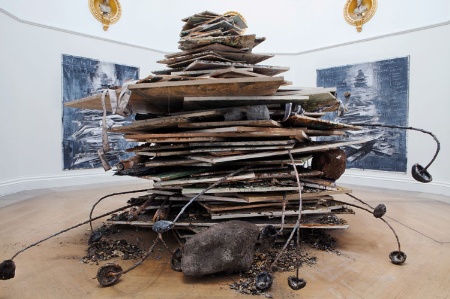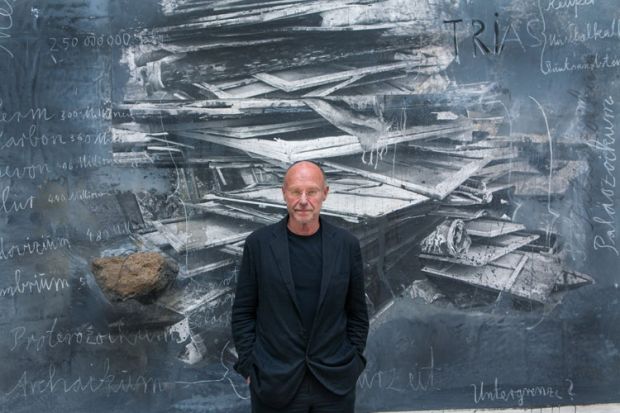Awed visitors circle it, a little warily. The material is infused with meaning; the stuff tells stories. The Kieferworld elicits wonderment
Anselm Kiefer
Royal Academy of Arts, London
September-14 December 2014
Anselm Kiefer
By Kathleen Soriano, Christian Weikop
and Richard Davey
Royal Academy of Arts
240pp, £48.00 and £28.00
ISBN 9781907533792 and 808
An original artist follows the path of the oculist, says Proust. Their art acts upon us like a course of treatment that is not always agreeable. “When it is over, the practitioner says to us: ‘Now look.’ And at this point the world (which was not created once and for all, but as often as an original artist is born) appears utterly different from the one we knew, but perfectly clear…Such is the new and perishable universe that has just been created. It will last until the next geological catastrophe unleashed by a painter or writer with an original view of the world.”
That geological catastrophe has just opened at the Royal Academy in London. It has Anselm Kiefer’s name on it. Like all great artists, his work is his own, an untracked continent as yet unnamed. Contrary to popular belief, it is given to artists, not politicians, to create a new world order. The Kieferworld is rich and strange, boundless and immersive, elemental and metaphysical. This artist traffics in fundamental truths. “Art is an attempt to get to the very centre of truth,” affirms Kiefer. “It never can, but it can get quite close.” At the same time, things are in flux. There is something cataclysmic about the Kieferworld. Heaven and earth take their chances in the rag and bone shop of the heart that is the artist’s studio. Kiefer’s studio is at once laboratory and crucible.
Perhaps the most striking quality of the cataclysm at the RA is the material. Kiefer sees artworks as actions, as he says, and not as consummate creations. The Kieferworld is in the process of perpetual transformation. Climate change has come indoors. The artworks slip and slide, corrode and erode. They age, and shed, and flake. They are weathered and distressed, scarred and mutilated. Violence is done to them, with a variety of weapons. Here are the survivors. They may or may not be happy in their skin. The dates of some of these works testify to an epic struggle: Ash Flower (1983-97), for example, a characteristic blend of oil, emulsion, acrylic paint, clay, ash, earth and dried sunflower on canvas - a canvas of continental proportions (382.3cm x 761.4cm), practically covering one end wall of gallery 3.

An installation made specially for the RA brings home the sense of action and transformation, and the sheer physical presence of these stupendous works. Ages of the World (2014), summarised rather coyly in the catalogue as mixed media, is a kind of recapitulation; it seems to speak of last things. The installation fills a whole gallery. It is described there as part totem, part funeral pyre. One might add part pyramid, part tomb; part sacrifice, part pile of the artist’s signature stuff. Awed visitors circle it, a little warily. The material is infused with meaning; the stuff tells stories. The Kieferworld elicits wonderment.
There is a place for belief in the Kieferworldview, belief in something above and beyond the featherless biped, but not a “salvator” or saviour. The artist’s outlook is perhaps more intellectual than spiritual. Kiefer is nothing if not a thinker-painter. Like Cézanne - another law student turned artist - he is a mighty reader. In an almost biblical sense the book is central to his practice. He makes books of his own (books of lead and books of words); he ransacks the pages of the poets for their wisdom. “I think in images,” he told the assembled company, accepting the Peace Prize of the German Book Trade in 2008. “Poems help me do this. They are like buoys in the sea. I swim to them, from one to the next; in between, without them, I am lost.”
He is a formidable intellectual. The lectures he delivered as chair of artistic creation at the Collège de France in 2010-11 are published under the title of Art Will Survive Its Ruins (2011), an apt title and an apt calling. Kiefer’s breadth and depth put common or garden professors to shame. His lectures are compelling, erudite, individual. As a thinker, he is both playful and profound. “Some artists wait all their life for the word of God, and it never comes. This is the case with K, who waits in vain in Kafka’s The Castle; and even more radically with Vladimir and Estragon in [Beckett’s] Waiting for Godot, who merely play at waiting. Like spoken words, a painting may happen to contradict itself. It is by nature an aporia. It feeds on chance, signifies everything but ordains nothing.”
Books and their authors are Kiefer’s interlocutors. He responds to them in his own idiom. This can produce surprising results. Invited recently to respond to The Cathedrals of France (1914), a book by the sculptor Auguste Rodin, Kiefer produced a book of his own with the same title (2013), combining studies of cathedrals with erotic watercolours: another speciality of the celebrated sculptor. One shameless sheet on view at the RA shows a lascivious nude with an erect cathedral in her lap - Rodin meets Magritte!

At once the most considered and the most sustained engagement is with the poems of Paul Celan (1920-70), entwined with those of Ingeborg Bachmann (1926-73), his lover, regarded by Kiefer as the greatest poet of
the second half of the 20th century. Celan’s Death Fugue is now canonical; for Kiefer it is a foundational text, as this exhibition triumphantly demonstrates. Bachmann’s Darkness Spoken is perhaps less well known, but no less vital:
The string of silence
taut on the pulse of blood,
I grasped your beating heart.
Your curls were transformed
into the shadow hair of night,
black flakes of darkness
buried your face.
Celan and Bachmann deal in the same darkness, broker the same black flakes. Kiefer pays tribute to the poems and the poets in his meditation on their plight. His exploration - one might better say his excavation - honours theirs: he probes the limits of language and the possibilities of art. “With art,” said Celan, “you go into your very selfmost straits. And set yourself free.” The Kieferworld is a free world, but a heavily burdened one, full of dead souls. Kiefer’s art is, among other things, an inquest and a reckoning - a reckoning with the history of the terrible 20th century.
Two vast canvases bracket that endeavour. For Paul Celan: Stalks of the Night (1998-2013), with a Kiefer-figure lying in the foreground, is framed through a series of arches in gallery 8, as if the image of the artist himself were impregnated in his work. Looking back through the arches, at the other end of the galleries is The Orders of the Night (1996), with another Kiefer-figure lying at the foot of the giant sunflowers that are a recurring motif in his work, redolent of another insistent interlocutor: Vincent Van Gogh, a painter-philosopher of heart-breaking eloquence.
There is lyric poetry after Auschwitz. The labours of Anselm Kiefer offer proof. Whatever else it may be, the Kieferworld is a challenge – an extraordinary feat of sustained creativity, an oeuvre that beggars belief. The result is monumental, inexhaustible, unmissable. Be brave. Go now. Think on.
Register to continue
Why register?
- Registration is free and only takes a moment
- Once registered, you can read 3 articles a month
- Sign up for our newsletter
Subscribe
Or subscribe for unlimited access to:
- Unlimited access to news, views, insights & reviews
- Digital editions
- Digital access to THE’s university and college rankings analysis
Already registered or a current subscriber? Login

